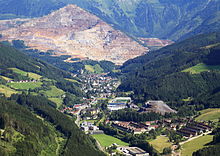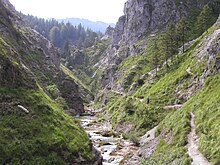Eisenwurzen
The Eisenwurzen is part of the Kalkvoralpen in the triangle of Lower Austria ( Mostviertel ), Upper Austria ( Traunviertel ) and Styria (Eastern Upper Styria ), bordered by the rivers Steyr , Ybbs and Erlauf including their side valleys. It is located in the Ybbstal Alps and the Reichraminger Hintergebirge , in the south the Hochschwab joins.
In addition to Eisenwurzen, the term Eisenstrasse also includes places on the other side of the Hochschwab, such as the Vordernbergertal and Leoben . The historical center is the Styrian Erzberg , whose economic importance shaped the surrounding region in the past. The region has now been proposed by the state of Austria to UNESCO as a World Heritage Site.
The area also includes some nature conservation areas, such as the Kalkalpen and Gesäuse national parks , the Ötscher – Tormäuer nature parks , Lower Austrian Eisenwurzen and Styrian Eisenwurzen , as well as the Dürrenstein wilderness area , one of the largest primeval forest areas in Central Europe.
geography
Originally a name for the Styrian Erzberg , the areas designated with the term Eisenwurzen were later expanded to include the entire area of what is now known as "Eisenstrasse". However, the part of the Styrian Eisenstrasse south and east of Eisenerz is not part of the Eisenwurzen. The Styrian part of the region is designated as a nature park.
Bertl Sonnleitner gave a broad description of the area:
“[…] The term always referred to the Innerberg (Eisenerz) facing area and thus already excluded the valleys further east, such as the Pielach or the Traisen, which were supplied from Vordernberg via the Seebergsattel.
From a geographical point of view, it is the area in the triangle of Lower Austria, Upper Austria and Styria, the extent of which used to correspond to that of the four dedication districts Scheibbs , Waidhofen an der Ybbs , Steyr and Windischgarsten , bounded in the west by the rivers Krems and Traun , in the north by the Danube , in the east by the Erlauf and in the south by the Hochschwab , the Eisenerzer Alps and the Pyhrn . Never a unit in the political sense, it nevertheless formed an all the more closed economic area, which with its industry made it possible to supply Austria, and even large parts of southern Germany, Bohemia, Hungary, the Balkans and above all Russia with all kinds of hardware. "
In addition to the Eisenerzer area, the Eisenwurzen includes in particular the center of the hammer mills in the Styrian Gesäuse and the Upper Austrian Ennstal to the trading town of Steyr , the Upper Austrian forest and mining regions in the Reichraminger Hintergebirge and Sengsengebirge ( Pyhrn – Eisenwurzen region ) and the Lower Austrian forest and small business areas Ybbstaler Voralpen and Lassingalpen .
Origin of name
The name Eisenwurzen comes from the iron processing there, which was very important between the 15th and 19th centuries due to the proximity of the Erzberg and the availability of wood, coal and water power in this region. The origin of the Wurzen part of the name is unclear, but seems to be related to the decentralized organizational structure of this economic area in the valleys of this mountainous region, some of which are difficult to reach: Starting from the center of Eisenerz , the transport routes meander like roots far into the surrounding country, and are distributed everywhere the production facilities. Another explanation leads this part of the name back to the time of alchemy . It was believed that the ore grows and thus has its roots in the depths. In the past, the Styrian Erzberg was also called “the beautiful Wurzen”, “the main sausage”. Many mining sites begin with the syllable "wheel", which is derived from the Latin word radix , the root.
history
In the 16th and 17th centuries, Eisenwurzen - like large parts of the Danube and Alpine countries - was largely Protestant. In the course of the forced recatholization, especially after the end of the Thirty Years' War, numerous evangelicals were expelled and had to look for a new home; In Franconia alone, over 1700 people from the Lower Austrian part of the region have been resettled in this context.
The special economic structure that has developed over centuries is known as the small iron industry . Industrial steel processing began with Andreas Töpper and Franz Wertheim , who from the 1820s bought some old hammers and expanded them. The decline of the ironmongery industry in Eisenwurzen was caused by industrialization from the 1860s. Today the term Eisenwurzen is therefore mainly of historical and tourist importance.
For further economic-historical aspects see also the article Small iron industry .
tourism
Tourist marketing usually uses the name Eisenstrasse for the region. Due to the activities in terms of tourism planning and advertising that are divided between three federal states, this tourism region is now also divided into the Styrian , Upper Austrian and Lower Austrian Eisenstrasse .
One of the centers and leading tourist destinations in Eisenwurzen, the city of Ybbsitz has long been a member of the Ring of European Forging Cities , and in 2010 forging in Ybbsitz was included in the UNESCO list of intangible cultural heritage in Austria , which further recognition of the industrial monument character of the entire region procured.
Lower Austrian Eisenwurzen
structure
The Lower Austrian Eisenwurzen only includes districts of the Mostviertel , specifically the districts
- Amstetten south of Waidhofen / Ybbs
- Waidhofen an der Ybbs
- Scheibbs
- Melk around Pöchlarn
- southwestern parts of the Lilienfeld district
and goes along the line Waidhofen an der Ybbs - Scheibbs seamlessly from the rugged mountain region to the hilly Mostviertel .
nature
In the area around the Ötscher in the southern part of the Scheibbs district, there are some scenic sensations. On the one hand, to the north and east of the Ötscher, there is the Ötscher-Tormäuer nature park with the 'Grand Canyon of Austria', and on the other, the largest primeval forest in Central Europe with 2400 hectares, the Dürrenstein wilderness area , where brown bears live in the wild.
The mountains of the Ybbstal Alps and the Göstling Alps are located in the Eisenwurzen area of Lower Austria . These include the Ötscher , the Dürrenstein , the Hochkar and the Gemeindealpe .
economy
The economic strength of Eisenwurzen in particular still lies in the iron , steel and wood processing industries. In the past, it was the hammer gentlemen who obtained the ore from the Erzberg ; today it is rolling mills that obtain semi-finished products from the Linz and Donawitz blast furnaces and process them into knives for machines, among other things. There are also some large and many small sawmills that process the wood from the surrounding forests, as well as paper mills on Ybbs and Erlauf . The majority of the economy, however, are small and medium-sized enterprises. The largest employers in the heartland are:
- voestalpine (steel),
- Mondi / Neusiedler (paper),
- Umdasch / Doka (wood / steel),
- IFE (automatic doors / entry systems),
- ZKW (automotive lighting),
- Forster (metal / street signs),
- Wittur (elevator components),
- Stora Enso Timber (wood),
- Welser Profiles (steel),
- Mosser (wood),
- Bene office furniture (wood / steel),
- Miller knife (steel),
- Busatis (steel),
- Riess (steel),
- Worthington (formerly Heiser) (gas bottles).
Former companies in Eisenwurzen were:
- Pottery works , Scheibbs, rolling mills
- Wertheim , Scheibbs, safes
- Gaißmayer & Schürhagel , Scheibbs, car axles
architecture
The most important design of the Lower Austrian Eisenwurzen are the Hammerherrenhäuser , mostly decorated with elaborate, predominantly gray-white sgraffito .
In the more northerly areas the building tradition is the same as that of the Mostviertel . However, the further south you go this mixes with alpine forms. So prevail hall churches before, as in St. Anton / Jeßnitz , Puchenstuben, Josefsberg and Joachim Berg, on the other hand are square courtyards replaced by couple and pile yards, but most of all by I-yards , which are the predominant Gutsform the region Eisenwurzen.
Also worth mentioning are the so-called Rothschild houses , which are mainly located in the Dürrenstein area.
See also
literature
- Gerald Radinger: The Kalkalpen hiking experience. The 50 most beautiful tours in the national park. Residenz-Verlag, St. Pölten et al. 2009, ISBN 978-3-7017-3133-6 .
Web links
Individual evidence
- ↑ Web page of the Austrian Eisenstrasse ( Memento from August 28, 2008 in the Internet Archive )
- ↑ Horst Weinek: A contribution to the term "Eisenwurzen". In: Res montanarum. Journal of the Mining History Association for Austria. 11, 1995, ISSN 1727-1797 , pp. 11-17.
- ↑ Manfred Enzner, Eberhard Krauß: Exulanten from the Lower Austrian Eisenwurzen in Franconia. A family and church history investigation (= sources and research on Franconian family history. 14). Society for Family Research in Franconia, Nuremberg 2005, ISBN 3-929865-09-2 .










